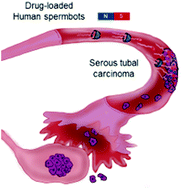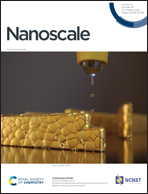Human spermbots for patient-representative 3D ovarian cancer cell treatment†
Abstract
Cellular micromotors are attractive for locally delivering high concentrations of drug, and targeting hard-to-reach disease sites such as cervical cancer and early ovarian cancer lesions by non-invasive means. Spermatozoa are highly efficient micromotors perfectly adapted to traveling up the female reproductive system. Indeed, bovine sperm-based micromotors have shown potential to carry drugs toward gynecological cancers. However, due to major differences in the molecular make-up of bovine and human sperm, a key translational bottleneck for bringing this technology closer to the clinic is to transfer this concept to human material. Here, we successfully load human sperm with Doxorubicin (DOX) and perform treatment of 3D cervical cancer and patient-representative ovarian cancer cell cultures, resulting in strong anticancer cell effects. Additionally, we define the subcellular localization of the chemotherapeutic drug within human sperm, using high-resolution optical microscopy. We also assess drug effects on sperm motility and viability over time, employing sperm samples from healthy donors as well as assisted reproduction patients. Finally, we demonstrate guidance and release of human drug-loaded sperm onto cancer tissues using magnetic microcaps, and show the sperm microcap loaded with a second anticancer drug, camptothecin (CPT), which unlike DOX is not suitable for directly loading into sperm due to its hydrophobic nature. This co-drug delivery approach opens up novel targeted combinatorial drug therapies for future applications.



 Please wait while we load your content...
Please wait while we load your content...